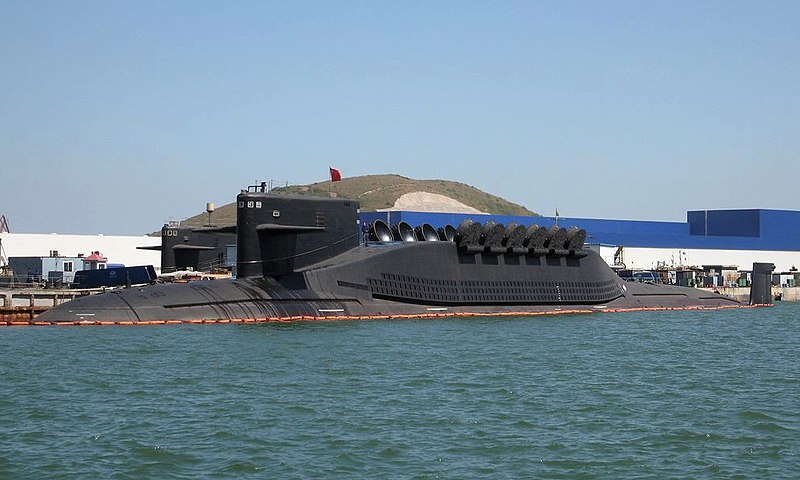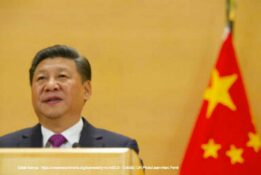Cet article s’interroge sur le lien entre la posture chinoise en Mer de Chine du Sud et la volonté de Pékin de moderniser sa composante nucléaire sous-marine. La poldérisation des îlots contrôlés par Beijing permettrait-elle à la flotte sous-marine stratégique chinoise de surmonter les obstacles géographiques et techniques auxquels elle doit faire face ? C’est la question qui structure l’analyse conduite par l’auteure.
Les opinions exprimées dans cet article n’engagent pas le CSFRS.
Les références originales de ce texte sont: « The South China Sea: China’s Next Nuclear Playground ». Blog de l’IFRI, Ultima Ratio
Esther Soulard, 4 septembre 2018
Ce texte, ainsi que d’autres publications, peuvent être visionnés sur le blog Ultima Ratio 
The South China Sea conflict has been largely put on the back burner, eclipsed by seemingly more pressing security issues in the Asia-Pacific. Yet, territorial disputes in the area continue to roil relations between regional countries and threaten to embroil the main claimants into a major conflict. At once a major strategic waterway and hotbed of economic activity, control of the South China Sea is sure to bring economic and geopolitical power – making possibilities for a diplomatic breakthrough between claimants – China, Vietnam, Malaysia, Taiwan, Indonesia, Brunei, and the Philippines – seem rather slim.
Situated at the crossroads of all major continents, the 3,5 million square kilometer maritime area is both the shortest maritime route between the Asia-Pacific to Europe and a major route connecting Middle Eastern and African countries to East Asian states. It is home to some one third of world trade – worth some five trillion dollars annually – as well as holds some seven billion barrels of proven oil reserves and an estimated 900 trillion cubic feet of natural gas. At the heart of most of the territorial disputes lies China, whose self-delineated maritime border – dubbed the Nine-Dash-Line – overlaps with all other plaintiffs’ exclusive economic zones. Not only has China claimed all of the region’s major archipelagos, namely the Spratly, Paracel and Pratas islands as well as the Scarborough Shoal and the Macclesfield Bank, it has backed up such claims with vast island-building projects and naval patrols.
Although securing access to the region’s resources surely accounts for much of China’s aggressive stance in the region, it is possible that its island-building spree and ongoing naval modernization is part of a larger ambition to acquire a credible sea-based second-strike capability. Its land reclamation activities and increasing militarization of the region coincide with the expansion of its nuclear submarine fleet hinting towards its intent to acquire a credible nuclear undersea deterrent. In such case, this has strong implications for global nuclear security altering the current status quo as well as significantly reshuffling regional power dynamics and the current military balance of power in the Sino-American relationship.
PART I.
China’s nuclear strategy is enshrined in revolutionary thinking and reflects both its intent to assure the country’s strategic autonomy and its revolutionary leaders belief in the power of people, rather than that of weapons. In fact, building a nuclear undersea deterrent dates back to the time of Mao Zedong, who famously declared in 1959 « We need to build a nuclear submarine, even if it takes us 10,000 years ». Despite China’s assertive behavior in the South China Sea, its nuclear posture, since its inception, has been grounded in self-imposed (and self-proclaimed) restraint as conveyed by its chief policy « No-First-Use ». The latter holds that nuclear weapons’ sole purpose is to deter a nuclear adversary from launching a nuclear attack by assuring to inflict unacceptable damage with a retaliatory attack. As such, the effectiveness of China’s nuclear strategy solely rests in the credibilityof its second strike capability, and so, acquiring a nuclear undersea deterrent constitutes a coherent objective with China’s historic No-First Use policy. Nuclear-powered ballistic missile submarines (SSBNs) present the undeniable advantages of being able to roam the depths of the ocean relatively undetected and protected from an adversary’s attack, as well as of launching a missile from an unknown location. In simpler terms, SSBNs offer China an invulnerable second-strike capability safeguarding the Asian power’s strategic autonomy.
Although the only remaining member of the Permanent 5 to not possess a SSBN operational capability today, China built its first SSBN model in 1981, the Type 092 (or Xia-class). Noisy and equipped with submarine-launched ballistic missiles (SLBMs) with a limited range of 1700+ km, it is said to have never conducted patrols outside Chinese regional waters. Since 2006, China has been developing a second SSBN model, dubbed the Type-094 (or Jin class) – recognized by the US Department of Defense as “China’s first credible, sea-based nuclear deterrent”. As of late 2017, the People’s Liberation Army counts at least four Jin SSBNs among its fleet, each capable of launching JL-2 submarine-launched ballistic missiles (SLBMs) with an estimated range of 7000+ km. However, the effectiveness of China’s second-strike undersea capability remains disputable. The limited range of JL-2 requires Chinese SSBNs to be deployed at least 3000 km east of Jianggezhuang base and over 4500 km from the Hainan base undetected in order to pose an effective threat to the continental US territory. Further, Jin submarines are reportedly noisier than 1970s Soviet-models and their nuclear reactors are reliable to a varying degree, rendering them notoriously vulnerable to anti-submarine warfare capabilities (ASW). According to the US Department of Defense, China is currently developing a new generation of SSBNs, the Type-096, along with new SLBMs, somewhat attesting that its nuclear submarine fleet requires improvement.
Moreover, command and control (C2) capabilities present a major technical challenge for all nuclear-powered navies and, as a newcomer to the world of SSBNs, it remains unclear if China has developed reliable communications infrastructure and established an effective command structure to efficiently connect its SSBNs to the homeland in times of crisis. Further challenging PLAN’s ability to conduct deterrent patrols are American ASW capabilities. Not only has the US pushed for regional integration of intelligence, surveillance and reconnaissance (ISR) activities, but it is also suspected of having installedan undersea sound surveillance system (SOSUS) extending north and south of Taiwan, hampering Chinese SSBNs’ access to the Pacific. In fact, in July 2013, Chinese media reported that Japan and the US had laid hydrophones in “Chinese waters” as part of a vast underwater monitoring system. Combined with the limited range of their ballistic missiles and their loud acoustic signatures, such a system undermines the survivability of SSBNs, possibly eroding China’s deployment of an undersea nuclear deterrent in the short term.
PART II.
Moreover, the Chinese SSBN fleet’s capacity to conduct open-ocean nuclear deterrence patrols is further hampered by the scarce channels available in the East and South Sea to access the Pacific Ocean. Attempts to mitigate such constraints may be tied to China’s militarization of the South China Sea. On the Spratly Islands, China has actively pursued land reclamation activities allowing it to expand its military defenses as well as build deep water ports, runways up to 3 km long and berthing facilities. China has also reportedly improved its C4ISTAR capabilities notably thanks to a network of some forty different radar facilities spread out over the Spratlys and naval and aviation communication systems transforming the archipelago into an air and sea base for intelligence, surveillance, and reconnaissance activities. This newly installed military infrastructure may shield its submarines from American ASW as well as provide the necessary support for its subsurface ASW capabilities. In other words, its land reclamation activities may ultimately allow China to curtail technical and geographical constraints obstructing the deployment of its SSBN fleet.
In fact, the militarization of the maritime area may point to PLAN’s decision to pursue a bastion strategy – not unlike that of the Soviet Union’s during the Cold War. Too vulnerable to allied ASW assets to conduct deterrent patrols outside protected waters, Soviet SSBNs were confined to the heavily guarded Sea of Okhotsk relying on the long range of their SLBMs to create an effective nuclear deterrent. Similarly, the construction of military outposts and airfields on the various disputed islands of the South China Sea may be part of a larger effort to build a ring of protection for Chinese SSBNs to patrol safely. Yet, the range of Jin submarines’ SLBMs remains limited undermining its second-strike capability in the event of a bastion strategy. Additionally, contrary to the Soviet Union, China does not control the South China Sea and any attempt to turn the maritime area into its bastion is likely to be resisted by seafaring nations and neighboring states.
But even without a bastion strategy, China’s military expansion in the South China Sea holds implications for its acquisition of a credible nuclear undersea deterrent. The erection of radar facilities and communication infrastructure on the various islands may allow PLAN to overcome command and control (C2) challenges as well as to mitigate some of its technical shortcomings. For example, albeit too noisy, its SSBNs may still be able to conduct deterrent patrols if shielded from American ASW activities. What is sure is that the construction of military outposts on the Spratly Islands has expanded the maritime area available for Chinese SSBNs to patrol protected and supported. To some extent, it partakes in a larger effort to transform the South China Sea into a fulcrum, providing PLAN with the military support to launch nuclear deterrence patrols in the future. Although it is possible that these patrols benefit strategic stability in the long term, it suggests that Chinese SSBNs will be at a high level of readiness at all times in the near future as well as heighten the risk of collisions and accidents due to miscommunication and/or technical malfunctions. The reshaped maritime geography of the South China Sea, along with PLAN’s technical advancements, in sum, will have long lasting consequences on global nuclear security. Ultimately, it is likely to facilitate China’s expansion of its maritime power concurring with the greater role the country is assuming at an international level.
To this day, no Chinese state official has formally recognized the strategic importance of the South China Sea for the country’s nuclear strategy; drawing links between the country’s militarization of the maritime area and its development of an effective sea-based second-strike capability remains thus precarious. Yet, it is clear that China is seeking to obtain a credible nuclear undersea deterrent – and its current land reclamation activities and subsequent militarization of the Spratly Islands, will enable PLAN to overcome both the geographical and technical constraints its SSBN fleet currently faces. While unlikely that China is pursuing a bastion strategy in the South China Sea, the construction of military outposts and airfields in the area is sure to facilitate its deployment of nuclear deterrence patrols in the future. Despite China’s aggressive stance in the area, obtaining a credible sea-based second-strike capability is arguably consistent with its historical view of nuclear weapons – believing SSBNs to be essential for its nuclear security and to protect itself from a nuclear attack and / or blackmail. From this perspective, it is unlikely that China will aim to achieve nuclear parity with the United States, inciting an arms buildup between the two powers.
Nonetheless, the South China Sea has become a hub of maritime confrontation exacerbated by China’s land reclamation activities. Efforts to resolve territorial disputes are at an impasse with opportunities for international arbitration limited by conflicting legal interpretations and the ongoing politicization of borders by regional governments. Even if not for the immediate future, China’s acquisition of a nuclear undersea deterrent is sure to intensify existing tensions and may demand that future attempts to resolve territorial and maritime disputes include a nuclear arms control component. And, given the economic and geopolitical power of the region, anyone with a stake in maritime commerce, or regional security, should be concerned, or at the very least, paying attention.
Par : Esther Soulard
Source : Institut Français des Relations Internationales


































